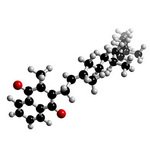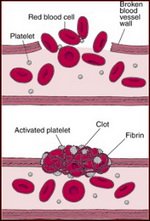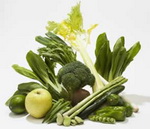|
Vitamin K – Its Role In Promoting Blood ClottingVitamin K is a member of a family of vitamin compounds known as quinones. The family of quinones contains phylloquinone, K1 which is a plant source of the compound, and menaquinones, K2 which is an animal source of the vitamin and also synthesized by the body’s intestinal bacteria, then there are the synthetic sources known as menadione, Synkayvite and Hykinone also known as K3.
Vitamin K Molecule
The most biologically active form of the vitamin is phylloquinone which is found in the diet, the animal form menaquinone is only 70% active, and the synthetics are only 20% active, menadione is fat soluble and like the natural forms is stored in the liver. The synthetics Synkayvite and Hykinone are water soluble, these two forms are considered to treat vitamin k deficiencies; however, menadione is not considered a safe form to use as a supplement. Functions of the Vitamin The functions of the vitamin are to promote clotting of the blood; this is a life or death function, because when you receive a cut, without the ability of the blood to clot, then you can ultimately bleed to death. This is done through the protein fibrin. Vitamin K's Role in Blood Clot Formation
In addition to its primary function as a clotting vitamin, the vitamin also assists in the formation of bone by promoting the strengthening of the skeleton. Dietary Recommendations The AI (adequate intake) for adult males is 120 micrograms/day and for adult women is 90 micrograms/day. The intake of vitamin K is dependent upon the normal intake and digestion of dietary fats, since it is a fat soluble vitamin. Vitamin Sources The vitamin is obtained from plant food primarily and from the bacteria living in our colons. The dietary form of the vitamin is absorbed in the small intestine and the vitamin produced by bacteria is absorbed in the colon.
The primary source of dietary phylloquinone can be found in green leafy vegetables, such as broccoli, brussels sprouts, spinach and turnip greens. Vegetable oils such as canola, cottonseed, olive and soybean oils are another source of the vitamin. Primary Dietary Sources of the Vitamin
Animal sources contain limited amounts of the vitamin, and it is small amounts of menaquinones that can be found in butter, some cheeses and egg yolks. Soybean products like tofu have substantial amounts of menaquinones and liver contains moderate amounts of menaquinones; however most people rarely ever eat liver and liver is one of those animal sources of high levels of cholesterol that we are cautioned about not over consuming anyway. Vitamin Deficiency The body only requires small amounts for its role in blood clotting and thus deficiencies of the vitamin are rare in healthy adults, but low intake of the vitamin is associated with low bone density in women and the risk for fractures. Those that suffer from fat absorption diseases such as Crohn’s diease, celiac disease, cystic fibrosis, sprue and ulcerative colitis may over time develop a deficiency of the vitamin.
It is especially noted in our overuse of antibiotics world that prolonged use of antibiotics can destroy the intestinal bacteria that produce the vitamin thus causing a deficiency of the vitamin. Prior to surgeries the levels of the vitamin is tested to determine the risk for hemorrhaging, because antibiotics are often prescribed as part of the treatment regimen. Vitamin K can also be interfered with by large doses of Vitamins A and E which counteract the actions of the vitamin.
Newborn babies lack the intestinal bacteria that produce the vitamin, and may become deficient as a result of not receiving the vitamin in the diet, especially if these babies are breast fed. Vitamin Toxicity Vitamin toxicity is rare, and although the vitamin is stored primarily in the liver and bone, the vitamin is excreted more than other fat soluble vitamins and thus it is rare for toxicity to occur.
For other information on nutrition, and vitamins in particular some great references are: • Nutrition – Fourth Edition by Paul Insel, Don Ross, Kimberley McMahon, and Melissa Bernstein
Vitamins
|








